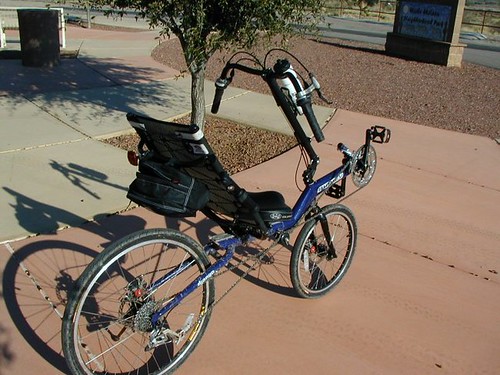The few (though they were becoming more frequent) times when I could get going and do so in a straight line, it was the same blessed feeling of freedom that all children experience on their first few tentative bike rides. Straight-line momentum being the best friend of balance in this circumstance, if I could just keep going I could pretend that I was an adult who'd been doing this for years. Then a stop sign or a car would intrude in my fantasy and the wibbling and wobbling would start anew.
Why, you may ask, was I going through all of this at 42? [An experience made all the more embarrassing and annoying by the fact that as a child, when presented with my first two-wheeler, I had simply gotten on and taken off, before my father had even had a chance to get the training wheels out of the box -- something I attribute more to my sense of independence than to any actual physical prowess on my part -- I am, after all, the one who would later run over my own leg with a lawn tractor.]
Even with treatment, carpal tunnel takes certain abilities away from its victims. In my case, the worst of these losses were the ability to hold a tennis racquet and the ability to support my upper body on the handlebars of a bike. Enter the Burley Django, a lovely purple recumbent bike picked up at a not-so-local bike shop so that I could join the bike culture of our newly adopted home, Tucson.
The design of a recumbent means that no weight gets born by the hands -- a blessing for those with carpal tunnel and other hand or arm problems. It also means that the body is in a completely different orientation to the ground, the bike, and the plane of motion than one is used to. So learning to ride a recumbent is exactly like learning to ride a bike all over again. And it takes just as long.
After a couple weeks of progressively more confident rides around the neighborhood, I was ready to head out into the big, wide world, and now Django and I are out there most mornings, enjoying the freedom and exhilaration of bike riding. I cannot thank Bruce, the friend who first suggested a recumbent, enough for giving me back the very simple pleasure that comes with hopping on a bike.

Django, like his owner, is outfitted for touring, not racing.
4 comments:
That's a great story! Good for you for figuring out a way to keep riding despite the carpal tunnel problems.
Go you!
I've always wanted to try a recumbent... now at least I don't harbor any false notions that I'll be zipping along the roads in no time! Thanks for this great intermediate sprint entry!
I can relate to this - I bought my Bacchetta Giro 5 weeks ago and I'm a few weeks short of 60.
I'm going well, but very slowly uphills, and occasionally falling off at low speed.
Keep it up; it's fun :0)
Post a Comment